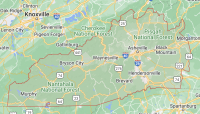UPDATED: Rangers hope to hunt down bear involved in weekend attack
 Rangers in the Great Smoky Mountains National Park shot a bear Tuesday that they believe is the same one that attacked a teenager sleeping in a hammock.
Rangers in the Great Smoky Mountains National Park shot a bear Tuesday that they believe is the same one that attacked a teenager sleeping in a hammock.
Rangers covertly staked out the campsite where the attack occurred Saturday night hoping the bear would come back. Bears generally keep to a given territory, and routinely return to the same places in their wanderings.
When a bear walked into the campsite Tuesday and mosyed around the area where the hammocks had been hanging, rangers suspected it was probably the same one and shot it.
“We took it very seriously and we didn’t take any chances,” said Dana Sohen, spokesperson for the park. “Nobody should have that fear when they are hiking that they are going to have an unprovoked bear attack.”
Rangers are still posted in the area in case the bear they shot wasn’t the right one — and still have the campsite staked out to see if another bear shows up. The general Hazel Creek area of the Smokies remains closed until further notice.
DNA tests could take two weeks to confirm a positive identity, based on bear hair samples taken from the scene of the attack.
Related Items
“There was a definite point of struggle and there was enough left behind at the scene to collect hair and blood,” Sohen said. The blood collected was that of the teenager’s, but it could be used to make a match, should the bear have any human blood traces on it that matched the victim.
New details have come out about the bear’s behavior during the attack. The bear was extremely difficult to drive away, according to park officials. After the bear dragged the teenager away, the teenager’s father had to beat it repeatedly to get it to let go.
“The boy's father saved his life, clearly,” Sohen said.
The bear then continued to circle the campsite.
The following story had gone to press Tuesday before word came through that a bear had been captured.
Trackers continue to comb the Great Smoky Mountains National Park for a black bear that attacked a person sleeping in a fabric hammock over the weekend.
But it could be a tall order. The bear run-in was in the wildest, most remote reaches of the park in Swain County, deep in the backcountry where the closest road is a day-and-half walk or a boat ride across Fontana Lake.
A slew of baited traps and motion sensor cameras have been set up in the Hazel Creek area, along with camouflaged rangers hiding in trees and behind wildlife blinds — lying in wait hoping the bear will return.
“I feel confident we’ll find it,” said Dana Soehn, spokesperson for the park. “Our guys are trained for this. That’s what they are good at.”
Outside tracking experts have been called in as well to help the park’s own team of rangers and wildlife biologists.
If they find the bear, it will be killed. There are 1,600 bears in the park, however, and knowing they got the right one is another challenge. Bears stick to a given territory, so the search area is roughly 20,000 acres or so — not the entire half million acres that comprise the park.
They also know generally what size bear they’re looking for. The father had estimated it was an adult bear, around 200 to 250 pounds.
Wildlife biologists will ultimately use a DNA test to confirm they got the right bear, using bear hairs collected from the person’s clothes and hammock.
In the meantime, the backcountry area around Hazel Creek in the Swain County section of the park is closed to hikers and campers. A swarm of rangers swept miles of trails to clear the area of hikers and campers Sunday, posting signs as they went to alert future hikers and campers to turn back.
It’s incredibly rare for a black bear to attack a person. Black bears are scavengers, not predators, and are naturally leery of people, rarely attacking them unless provoked.
“They aren’t predatory in nature but are looking for an easy meal,” said Justin McVey, a biologist and bear expert with the N.C. Wildlife Resources Commission.
Bears usually don’t lash out unless they feel threatened, or are trying to get food. But that doesn’t seem to be the case here.
The bear pulled the sleeping teenager out of a hammock by his head. His father was asleep in his own hammock nearby.
Based on what the father told rangers, their backpacks — food and all — were hoisted high into the air using overhead bear cables installed at the backcountry park campsites.
“A lot of times people don’t think about the smellable items like toothpaste and deodorant that can still attract bears,” Soehn said, but even those had been put up.
“This certainly sounds like an unprovoked bear attack. That is very rare,” Soehn said.
So rare, in fact, that black bear experts are scratching their heads and looking for possible explanations.
“My feeling is the bear was basically curious and kind of exploring,” McVey postulated. “Bears are sometimes a little like babies — they put something in their mouth to figure out what something is.”
That could explain why the bear put his mouth around the boy’s head and drug him around, but didn’t bite down hard enough to kill him.
Bill Lea, a renown black bear photographer from Franklin, is saddened that the bear is being portrayed as a killer at large who must be put down. Black bears in the Smokies simply don’t attack humans. But they are curious.
“If there is something different in his woods, he is going to come to investigate,” Lea said. “A person laying in a hammock does not appear to be a person to a bear. I don’t think the bear had any idea that it was a human.” Backpacking hammocks aren’t like the backyard rope-netting variety. They are made of a nylon-like fabric, and wholly ensconce a person like a giant sack.
Lea postulated that the teenager had residual food smells on him — to be expected after three-days of hiking and sleeping in the wilderness.
“The bear goes up and investigates. The kid wakes up and scares the bear so it sees fight or flight,” Lea said. “It probably scared the you know what out of the bear.”
Lea disagrees with the park’s reasoning that the bear is a threat to people now and has to be killed.
“If that person had been standing up, the bear would have never ever done anything,” Lea said.
Lea is something of a Jane Goodall when it comes to black bears. He’s spent decades quietly observing wild bears in the woods. And he’s learned to read their body language.
Even bears who feel threatened will communicate first, and attack only as a last resort. Lea knows the telltale sign of flattened ears, lowered head, and rolled up eyes.
“I call that the look. What follows next is a bluff charge. Those are two warnings that say, ‘Hey I am not comfortable. You are too close. Back off.’”
It’s often described as aggressive behavior, but to Lea, it’s the bear’s way of communicating.
McVey agreed with Lea that the bear was likely exploring the hammock out of curiosity rather than some premeditated intent to attack and eat a person.
But he didn’t rule out the rare instance of a black bear maiming or killing a person. The Smokies has an estimated 1,600 bears and 10 million visitors, McVey pointed out.
“You have a place where there are lots and lots of bears in a highly visited park with lots and lots of people,” McVey said.
Despite that, there’s only been one person killed by bears in the park. A woman alone on a trail was presumably killed by a bear in 2000, although no one witnessed the attack to know exactly what led up to it.
Lea hopes bears aren’t vilified over the incident.
“There is no reason to panic. Bears aren’t out there seeing people as food,” Lea said. “Turn on the evening news — there’s your wild and unpredictable species.”









